SF_PSE block
Function block
This function block is a safety-related function block for monitoring pressure sensitive equipment (PSE) such as safety mats, bumpers, etc.
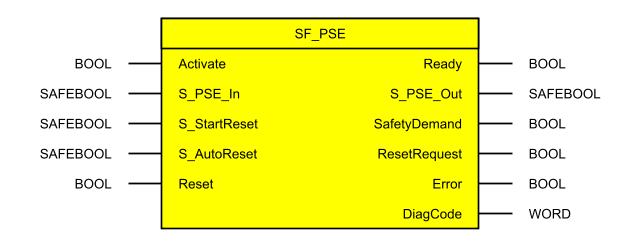
Interface
|
I/O |
Name |
Data type |
Initial value |
Description |
|
IN |
Activate |
BOOL |
FALSE |
|
|
IN |
S_PSE_In |
SAFEBOOL |
SAFEFALSE |
Variable. Safety request input SAFEFALSE: PSE actuated, prompt for safety-related reaction. SAFETRUE: PSE not actuated, no prompt for safety-related reaction. The safety control system must be able to detect a very short interruption of the PSE (which is specified in EN 1760: at least 200 ms) when the PSE is used as a safety device in applications. |
|
IN |
S_StartReset |
SAFEBOOL |
SAFEFALSE |
|
|
IN |
S_AutoReset |
SAFEBOOL |
SAFEFALSE |
|
|
IN |
Reset |
BOOL |
FALSE |
|
|
OUT |
Ready |
BOOL |
FALSE |
|
|
OUT |
S_PSE_Out |
SAFEBOOL |
SAFEFALSE |
Output for the safety-related reaction. SAFEFALSE: Safety output disabled. Request for a safety-related reaction (e.g. reset requested or internal error active). SAFETRUE: Safety output enabled. No requirement for a safety-oriented reaction. |
|
OUT |
SafetyDemand |
BOOL |
FALSE |
|
|
OUT |
ResetRequest |
BOOL |
FALSE |
|
|
OUT |
Error |
BOOL |
FALSE |
|
|
OUT |
DiagCode |
WORD |
16#0000 |
Function description
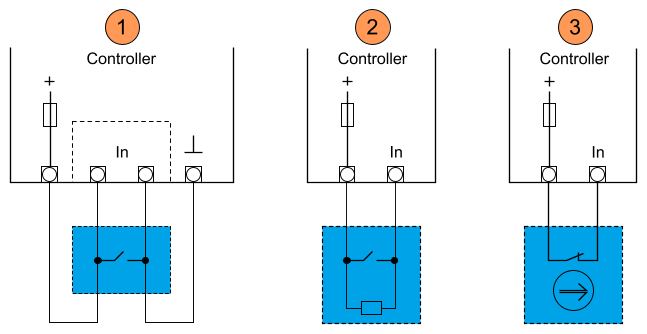
|
1) |
Short-circuit-proof design (energize-to-trip principle) - 4-wire variant |
When the protective equipment is activated, a short circuit occurs in the circuit (several Ω). This design requires a more complex evaluation. |
|
2) |
Short-circuit-proof design (energize-to-trip principle) - Resistor variant |
A short circuit occurs when the protective equipment is activated. A change from a set resistance (in the range of kΩ) is detected. This design requires a more complex evaluation. |
|
3) |
Positive opening contact design (re-energize-to-trip principle) |
This design is more universal and has advantages. As with a safety switch, a switching contact is opened when the protective equipment is activated. A short circuit is prevented by special wiring. |
The function block requires a FALSE signal to activate the safety function. Therefore, a PSE with positive opening contact design (see figure above no. 3) can be connected directly to a safety input device. However, the other 2 principles (see no. 1 and 2 in the figure above) require an evaluation unit to generate the corresponding FALSE signal when the PSE is actuated.
The function is identical to SF_EmergencyStop (except for the 2 additional outputs SafetyDemand and ResetRequest). Output signal S_PSE_Out is set to SAFEFALSE as soon as input S_PSE_In is set to SAFEFALSE. Output signal S_PSE_Out is only reset to SAFETRUE if input S_PSE_In is set to SAFETRUE and a reset occurs. The enable reset depends on the defined inputs S_StartReset, S_AutoReset and Reset.
If S_AutoReset = SAFETRUE, acknowledgment is automatic.
If S_AutoReset = SAFEFALSE, a rising trigger on input Reset must be used to acknowledge the enable.
If S_StartReset = SAFETRUE, the acknowledgment is automatic and the PES is started for the first time.
If S_StartReset = SAFEFALSE, a rising trigger on input Reset must be used to acknowledge the enable.
Inputs S_StartReset and S_AutoReset are only permitted to be enabled if it has been ensured that no hazardous situation can occur when the PES is started.
Additional information
S_StartReset = SAFEFALSE and S_AutoReset = SAFEFALSE
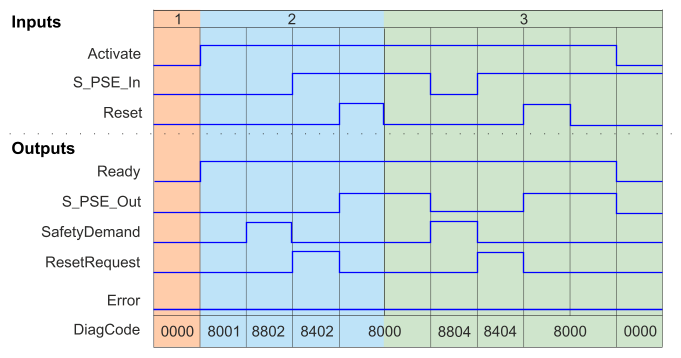
1) Wait
2) Startup sequence
3) Normal operation with reset
S_StartReset = SAFETRUE and S_AutoReset = SAFEFALSE
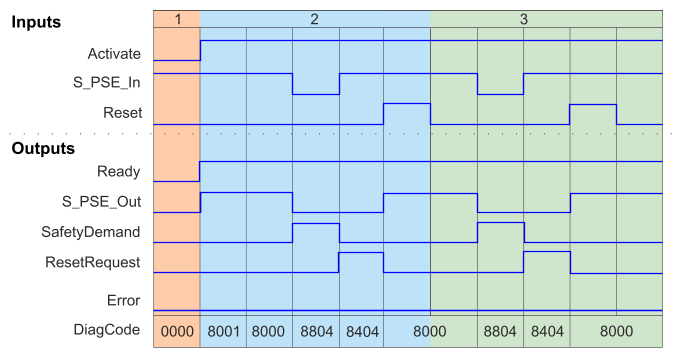
1) Wait
2) Startup sequence with S_StartReset
3) Normal operation with reset
S_StartReset = SAFEFALSE and S_AutoReset = SAFETRUE
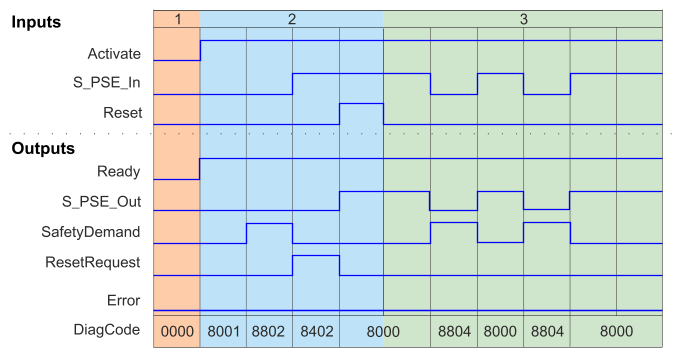
1) Wait
2) Startup sequence
3) Normal operation with S_AutoReset
Error detection
The function block detects a static TRUE signal on input Reset .
Error behavior
S_PSE_Out is set to SAFEFALSE. With a static TRUE signal on input Reset, output DiagCode displays the corresponding error code and output Error is set to TRUE.
Reset must be set to FALSE to exit the error states.
Error and status messages
Function block specific error codes
|
DiagCode |
Name |
Description and output settings |
|
C001 |
Reset error 1 |
Reset is TRUEwhile waiting for S_PSE_In = SAFETRUE. Ready = TRUE S_PSE_Out = SAFEFALSE SafetyDemand = FALSE ResetRequest = FALSE Error = TRUE |
|
C011 |
Reset error 2 |
Reset is TRUEwhile waiting for S_PSE_In = SAFETRUE. Ready = TRUE S_PSE_Out = SAFEFALSE SafetyDemand = FALSE ResetRequest = FALSE Error = TRUE |
Function block-specific status codes (no error)
|
DiagCode |
Name |
Description and output settings |
|
0000 |
Idle |
Function block is not active (initial state). Ready = FALSE S_PSE_Out = SAFEFALSE SafetyDemand = FALSE ResetRequest = FALSE Error = FALSE |
|
8001 |
Init |
Activate is TRUE. The function block has been enabled. Whether S_StartReset is required must be checked. Ready = TRUE S_PSE_Out = SAFEFALSE SafetyDemand = FALSE ResetRequest = FALSE Error = FALSE |
|
8802 |
Wait for S_PSE_In 1 |
Activate is TRUE. Whether Reset is FALSE and waiting for S_PSE_In = SAFETRUE must be checked. Ready = TRUE S_PSE_Out = SAFEFALSE SafetyDemand = TRUE ResetRequest = FALSE Error = FALSE |
|
8402 |
Wait for reset 1 |
Activate is TRUE and S_PSE_In is SAFETRUE. Waiting for rising reset trigger. Ready = TRUE S_PSE_Out = SAFEFALSE SafetyDemand = FALSE ResetRequest = TRUE Error = FALSE |
|
8804 |
Wait for S_PSE_In 2 |
Activate is TRUE. Safety request detected. Whether Reset = FALSE and waiting S_PSE_In = SAFETRUE be must be checked. Ready = TRUE S_PSE_Out = SAFEFALSE SafetyDemand = TRUE ResetRequest = FALSE Error = FALSE |
|
8404 |
Wait for reset 2 |
Activate is TRUE and S_PSE_In is SAFETRUE. S_AutoReset must be checked or wait for the rising trigger of Reset. Ready = TRUE S_PSE_Out = SAFEFALSE SafetyDemand = FALSE ResetRequest = TRUE Error = FALSE |
|
8000 |
Safety output enabled |
Activate is TRUE and S_PSE_In is SAFETRUE. Function mode with S_PSE_Out = SAFETRUE. Ready = TRUE S_PSE_Out = SAFETRUE SafetyDemand = FALSE ResetRequest = FALSE Error = FALSE |